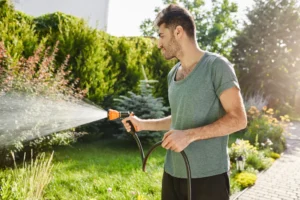 Artificial turf, also known as synthetic grass, has become increasingly popular as a sustainable landscaping solution that helps conserve water. By replacing natural grass with artificial turf, homeowners and businesses can significantly reduce their water usage and contribute to water conservation efforts.
Artificial turf, also known as synthetic grass, has become increasingly popular as a sustainable landscaping solution that helps conserve water. By replacing natural grass with artificial turf, homeowners and businesses can significantly reduce their water usage and contribute to water conservation efforts.
The connections between artificial turf and water savings are undeniable. By choosing artificial turf for landscaping projects, individuals and communities can contribute to water conservation efforts, reduce water usage, mitigate environmental impacts, and promote long-term sustainability. With its numerous benefits, artificial turf emerges as a practical and eco-friendly alternative to traditional grass lawns in the quest for a greener and more sustainable future.
Let’s explore the connections between artificial turf and water savings.
1. Reduced Water Consumption
One of the most significant benefits of synthetic turf is its ability to reduce water consumption drastically. Unlike natural grass, which requires regular watering to maintain its lush appearance, artificial turf does not need irrigation. This eliminates the need for daily or weekly watering, saving thousands of gallons of water each year.
2. Drought Resistance
Artificial turf remains green and vibrant even during drought conditions when natural grass may turn brown and wilt. Its synthetic fibers retain their color and texture without the need for supplemental watering, ensuring a consistently lush lawn regardless of rainfall or water restrictions.
3. Elimination of Irrigation Systems
Maintaining a natural grass lawn often requires the installation and upkeep of irrigation systems, which can be costly and resource-intensive. With synthetic turf, there is no need for irrigation systems, saving homeowners and businesses both time and money on installation, maintenance, and water bills.
4. Conservation of Precious Resources
Water is a finite resource, and conserving it is crucial for sustainability and environmental stewardship. Individuals and communities can play a significant role in conserving water resources and reducing their overall environmental impact by choosing artificial turf over natural grass.
5. Mitigation of Runoff and Erosion
Artificial turf helps mitigate runoff and erosion, especially in areas prone to soil erosion and water runoff. Its dense and permeable surface allows rainwater to infiltrate the soil more effectively, reducing the risk of erosion and promoting groundwater recharge.
6. Environmental Benefits
In addition to water savings, artificial turf offers various environmental benefits. It eliminates the need for chemical pesticides, fertilizers, and herbicides commonly used on natural grass lawns, reducing chemical runoff and pollution in waterways. It also eliminates emissions from lawnmowers and other gas-powered equipment, contributing to improved air quality.
7. Long-Term Sustainability
Artificial turf is a long-term landscaping solution that provides lasting water savings and environmental benefits. Its durable and resilient nature ensures years of maintenance-free enjoyment, making it a sustainable choice for homeowners, businesses, and communities looking to conserve water and promote environmental stewardship.
The Smart Choice for Homeowners in Tampa Bay
Artificial turf emerges as a smart, cost-effective choice for homeowners in the Tampa Bay area. It eliminates the need for water, pesticides, and continuous maintenance, providing a safe, eco-friendly, and easy-to-maintain alternative to natural grass. To explore the benefits of artificial turf for your home near Tampa, consult with the experts at Turf Pro Synthetics, a leading artificial grass installer in Tampa Bay.
Picture Credit: Freepik
